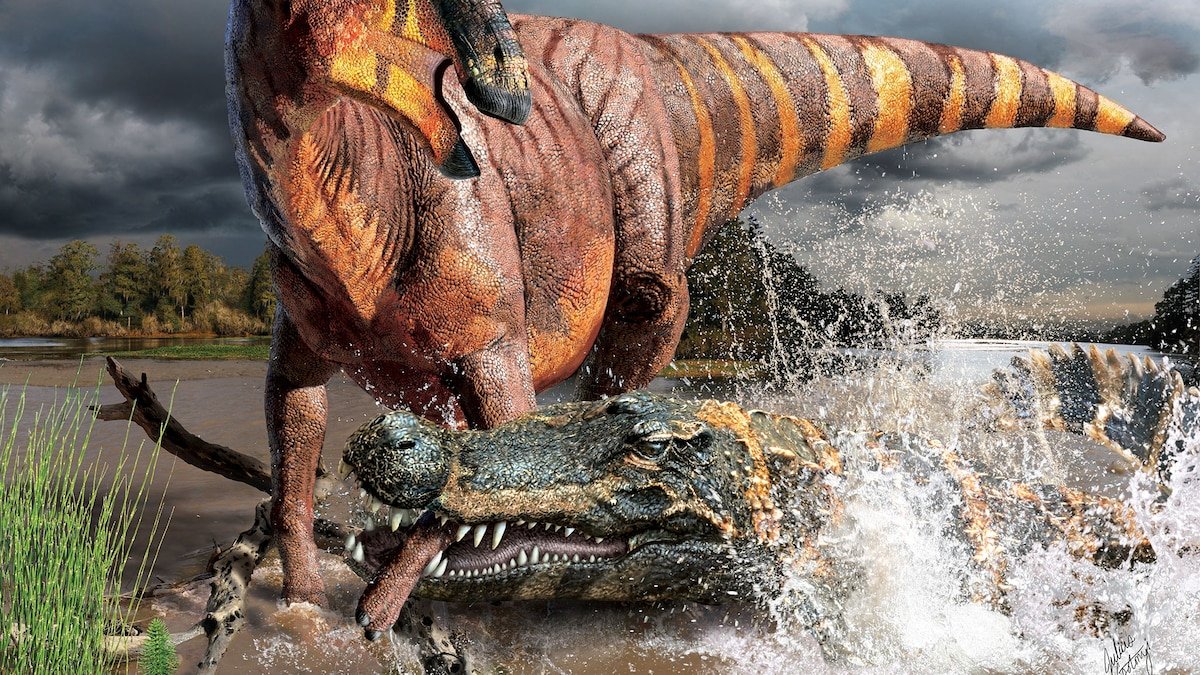Around 75 million years ago, North America’s largest and most formidable carnivore was not a dinosaur—but a croc. Deinosuchus, the “terrible crocodile” in Greek, could reach more than 35 feet in length and weigh over five tons. Bite marks on bones leave no doubt that the immense reptile caught and ate dinosaurs. How Deinosuchus became such a large and widespread predator, however, has been a mystery.
Now, a new study published today in Communications Biology claims to have solved the puzzle—by shifting where Deinosuchus fits in the croc family tree and, potentially, how tolerant the reptiles were of salty habitats. “We wanted to better understand how Deinosuchus became this successful top predator of coastal wetlands all over North America, why it grew so large,” says Márton Rabi, a paleontologist at the University of Tübingen in Germany and a coauthor on the paper.
A new place in the croc family tree
Paleontologists have been on the trail of Deinosuchus since a pair of fossilized teeth were found in North Carolina in 1858. Since that time the reptile’s fossilized teeth, bony armor, skull pieces, and skeletal parts have been found in Mexico, Utah, Texas, Montana, South Carolia, New Jersey, and more, popping up along the edges of North America’s prehistoric coastlines in rocks 82 to 72 million years old. In the lowland marshes and swamps of Cretaceous North America, Deinosuchus watched and waited for prey to get close enough to bite.
Paleontologists categorized the three known Deinosuchus species as alligatoroids, the broad group that contains the American alligator and Chinese alligator today. The broad, rounded snout of Deinosuchus certainly carried a resemblance to alligators more than other crocodilians, the reptile group that includes both crocodiles, alligators, and their relatives, hinting at a close relationship.
After running a new comparison of family relationships, the researchers have questioned the traditional view and recategorized the massive reptile. Instead, the study suggests, Deinosuchus belonged to an ancient lineage that split off before the last common ancestor of today’s alligators and crocodiles, carrying characteristics that are seen in both groups. This allowed the ancient croc to thrive among saltier habitats like estuaries and ocean coasts like saltwater crocodiles do today.
“We were surprised to find out that Deinosuchus was not a ‘greater alligator,’” Rabi says. The team argues that the reptile’s alligator-like appearance was likely a matter of convergent evolution rather than a family resemblance.
You May Also Like

New York Institute of Technology paleontologist Adam Cossette, who was not involved in the new study, questions some of the methodologies used to construct the new family tree but notes that the new placement makes sense as Deinosuchus fossils show an array of traits seen in alligators and crocodiles, as well as some features “usually found very deep in the tree.”
Rabi and coauthors wondered if the new classification could explain how Deinosuchus came to live in freshwater and saltwater habitats as geographically distant as Mexico and New Jersey. Alligators tend to prefer freshwater habitats, while many crocodiles are more tolerant of salt water. The researchers argue that Deinosuchus was more like a saltwater crocodile than an American alligator and, in addition to following coastal habitats, swam across a prehistoric sea that divided North America in two halves during the late Cretaceous.
Other researchers are skeptical of the argument, however. “I disagree with species of Deinosuchus being saltwater tolerant,” Cossette says, noting that Deinosuchus found in Texas, for example, lived in freshwater environments that were not especially close to the coast. Deinosuchus fossils in Utah, as well, are found with freshwater fish and reptiles in habitats that were not especially close to the coast. It may be that Deinosuchus preferred freshwater but was capable of foraging in and traversing saltier waters when necessary.
“The abundance of Deinosuchus fossils in coastal deposits is a reflection only of the conditions for preservation,” adds University of Bristol paleontologist Max Stockdale, who was not involved in the new study. The shoreline is only part of the picture. Deinosuchus may have lived in environments not recorded in the fossil record. Additionally, Stockdale notes, freshwater species like Nile crocodiles and American alligators have been known to swim between ocean islands or spend time at sea, so the case for Deinosuchus remains inconclusive based on available evidence.
How to grow a giant croc
Even as paleontologists still the particulars of Deinosuchus biology, there is no doubt that the predator was big. The fossils of Deinosuchus are often found in the same formations as the carnivorous tyrannosaurs, for example, but Deinosuchus could grow to be longer and more massive than the tyrant dinosaurs, making it a true apex predator. The croc even had a bite force greater than T. rex, though the two didn’t coexist. In order for Deinosuchus to thrive, there had to be plenty of food. The broad range of the carnivore indicates that there was a great deal of suitable habitat to support such a gargantuan meat-eater.
“You need two things for growing giant crocs,” Rabi says, which are a fast growth rate early in life and a consistent food supply to fuel that rapid growth. During the late Cretaceous, when Deinosuchus lived, high global sea levels and a warm climate fed incredible growth within marshes and swamps everywhere the sea touched North America. The nature of these aquatic ecosystems, the new study proposes, allowed such giant reptiles to evolve in the first place.
“The high-productivity wetlands, including prey species, were critical for the evolution of Deinosuchus,” Rabi says, a pattern that is seen among other giant, prehistoric crocs such as Sarcosuchus that lived in ancient Africa and South America about 120 million years ago and the broad-snouted Purussaurus of South America between 16 and 5 million years ago.
Food wasn’t the only factor for giant, cold-blooded crocs. “The gigantism we see in Deinosuchus is a reflection of stability in the environment,” Stockdale cautions, especially as Deinosuchus would have relied on the temperature of its environment to regulate its body temperature. Conditions had to be just right for a long time to allow such a croc to evolve. Such ecosystems have evolved several times over in Earth’s history, fueling the growth of giants like Deinosuchus. Perhaps someday they will again.











